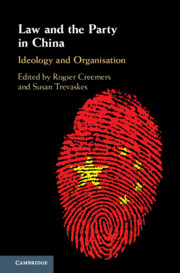Book contents
- Law and the Party in China
- Law and the Party in China
- Copyright page
- Contents
- Contributors
- Abbreviations
- 1 Ideology and Organisation in Chinese Law
- Part I Ideology and the Party in Law
- Part II Ideology and the Party in Law and Organisation
- 6 Seeking Truthful Names
- 7 The ‘Organisational Weapon’ of the Chinese Communist Party
- 8 Disorientation for the New Era
- 9 Technologies of Risk and Discipline in China’s Social Credit System
- Glossary of Chinese Terms
- Index
- References
9 - Technologies of Risk and Discipline in China’s Social Credit System
from Part II - Ideology and the Party in Law and Organisation
Published online by Cambridge University Press: 17 December 2020
- Law and the Party in China
- Law and the Party in China
- Copyright page
- Contents
- Contributors
- Abbreviations
- 1 Ideology and Organisation in Chinese Law
- Part I Ideology and the Party in Law
- Part II Ideology and the Party in Law and Organisation
- 6 Seeking Truthful Names
- 7 The ‘Organisational Weapon’ of the Chinese Communist Party
- 8 Disorientation for the New Era
- 9 Technologies of Risk and Discipline in China’s Social Credit System
- Glossary of Chinese Terms
- Index
- References
Summary
Adam Knight’s study on China’s social credit system examines how the Party-state is currently harnessing technology to automate processes for consolidating and expanding its power. Knight traces the development of the system from its origins as a ‘technology of risk’ in the financial services market to its current-day role as a disciplinary ‘technology of regulation’, in operation to realise a state-arbitered moral ideal. The social credit system has evolved in recent years on two fronts, organisationally and conceptually. Organisationally, social credit’s evolution reflects a movement in policy innovation and implementation from the centre to the periphery. Conceptually, social credit has developed from a narrow policy goal to an increasingly broad array of punishment and reward initiatives as part of a political move by the Party to promote the ideological spread of what Knight calls chengxin (诚信) culture (‘sincerity and honesty’ culture) under Xi Jinping.
- Type
- Chapter
- Information
- Law and the Party in ChinaIdeology and Organisation, pp. 237 - 262Publisher: Cambridge University PressPrint publication year: 2021
References
- 4
- Cited by



